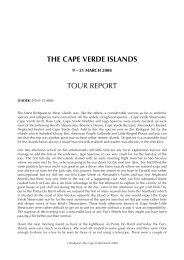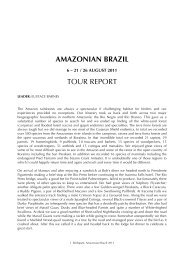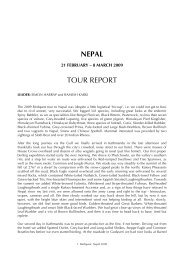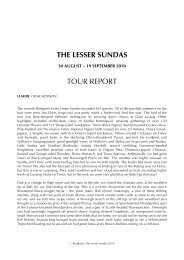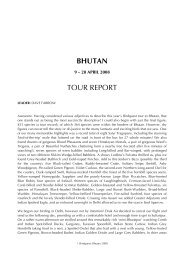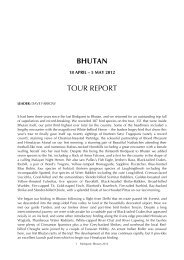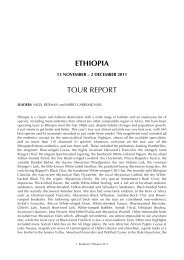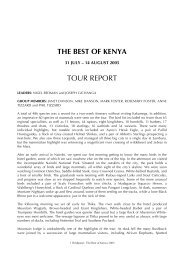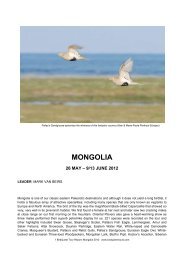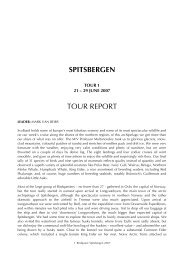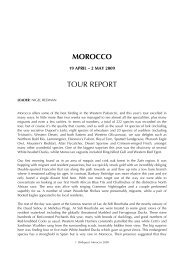Download Full Tour Report 1202kb - Birdquest
Download Full Tour Report 1202kb - Birdquest
Download Full Tour Report 1202kb - Birdquest
You also want an ePaper? Increase the reach of your titles
YUMPU automatically turns print PDFs into web optimized ePapers that Google loves.
Stripe-chested Antwren Myrmotherula longicauda: A foothill relative of the previous, seen nicely<br />
below Cock-of-the-Rock Lodge.<br />
Plain-throated Antwren Myrmotherula hauxwelli: Small numbers of this distinctive antwren were<br />
seen and heard. Of all the Amazonian antwrens, the one that lives closest to the ground.<br />
White-flanked Antwren Myrmotherula axillaris: At Romero this common member of mixed flocks<br />
proved to be one of the birds-of-the-trip with a wing-pumping call display that left us all<br />
very impressed!<br />
Long-winged Antwren Myrmotherula longipennis: Very responsive and excellent views at Amazonía<br />
and elsewhere. A species exhibiting a fair bit of geographic variation, as so often more so<br />
in female than in male plumage. Here the race garbei.<br />
Ihering’s Antwren Myrmotherula iheringi: We all had excellent views of this localized antwren in the<br />
Manu lowlands.<br />
Grey Antwren Myrmotherula menetriesii: We had at least 8 sightings of this drab but common<br />
antwren of mid-levels. Here the nominate race, in males usually showing a variable black<br />
throat patch (unlike e.g. Ecuadorian birds which have no black on the throat).<br />
Banded Antbird (B Antwren) Dichrozona cincta: Another tour highlight was seeing this delicate<br />
understorey antwren perched up on a log at Romero.<br />
Yellow-breasted Antwren Herpsilochmus axillaris: Several of us saw a vocalizing bird in a mixed<br />
flock below Cock-of-the-Rock Lodge.<br />
Dot-winged Antwren Microrhopias quixensis: One of the prettier antwrens, named after the Rio<br />
Quijos in Ecuador. Also this one shows a fair amount of geographical variation, birds in<br />
the Manu region being of the race albicauda.<br />
Striated Antbird Drymophila devillei: A cooperative and very elegant bamboo denizen.<br />
Peruvian Warbling-Antbird Hypocnemis peruviana: This was the white-breasted form seen by most<br />
of us in the forest interior of Manu Wildlife Centre.<br />
Yellow-breasted Warbling-Antbird Hypocnemis subflava: We saw this yellow-bellied species on<br />
several occasions in the Manu lowlands, always in bamboo.<br />
Chestnut-shouldered Antwren Terenura humeralis: Difficult but identifiable canopy views for some<br />
of us at Romero.<br />
Yellow-rumped Antwren Terenura sharpei: Another difficult sighting of a canopy bird only just seen<br />
by a few of us out during siesta time at Cock-of-the-Rock Lodge.<br />
Grey Antbird Cercomacra cinerascens: A bird of mid-storey vine tangles, eventually surrendering at<br />
Romero but only for some. Here the race sclateri, with prominent white wing-covert<br />
spotting.<br />
Riparian Antbird Cercomacra fuscicauda (H): We heard this lowland form on the bamboo trail of<br />
Manu Wildlife Centre; it is often lumped with vocally distinct Andean foothill forms as<br />
Blackish Antbird C. nigrescens.<br />
Black Antbird Cercomacra serva (H): Heard in thickets along the Manu road.<br />
Manu Antbird Cercomacra manu: Good views of this bamboo specialist, a species only recently<br />
described from this area, but now found locally in bamboo in Bolivia and Brazil. This<br />
antbird is one of the 6 obligate bamboo users in southeast Peru, where in total there are<br />
19 species of birds considered to be bamboo-specialists, all varying in their dependence<br />
on bamboo. Many of these have sister taxa in southeast Brazil which are also bamboo<br />
specialists, suggesting that this specialization may have evolved when the two areas were<br />
connected by bamboo during the Miocene. Through satellite imagery we know that in<br />
southeast Peru, bamboo forests cover more than 180,000 sq. km., an area three times the<br />
size of Costa Rica.<br />
White-backed Fire-eye Pyriglena leuconota: We all eventually saw this understorey skulker below<br />
Cock-of-the-Rock Lodge. Here of the race marcapatensis, in the maura subspecies group,<br />
more than one species may be involved.<br />
White-browed Antbird Myrmoborus leucophrys: We all had great looks at this stunning antbird from<br />
the Manu road. Their staccato like song was heard daily in the Manu lowlands.<br />
28 <strong>Birdquest</strong>: The Manu 20011




